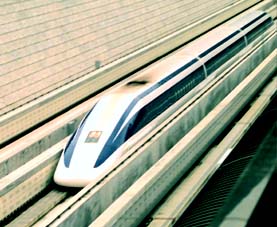 In a test run on December 24, 1997, a driverless magnetically levitated (maglev) train set a new world speed record of 550 kilometers (341 miles) per hour on an 18-kilometer (11-mile) test track in Yamanashi Prefecture.
In a test run on December 24, 1997, a driverless magnetically levitated (maglev) train set a new world speed record of 550 kilometers (341 miles) per hour on an 18-kilometer (11-mile) test track in Yamanashi Prefecture.
An earlier sprint on December 13 of the prototype maglev train had broken a world record for a manned run when it sped along at 531 kilometers (330 miles) per hour.
The developers of the maglev--Central Japan Railway Co. (JR Tokai) and the Railway Technical Research Institute--had been hoping to get the train to rush along at 550 kph, an important threshold to assure sustained, high-speed performance in commercial operation, scheduled for early next century.
JR Tokai plans to build a maglev line between Tokyo and Osaka via Yamanashi and Nagano with cars speeding along at a maximum speed of 500 kph (311 mph). When completed, the new service should cut travel time between Tokyo and Osaka to about an hour.
The maglev is floated above the tracks after it reaches around 100 kph (62 mph). By magnetically levitating the train, friction can be reduced, and extremely high speeds can be achieved.
JR Tokai and the research institute took over the maglev program from the Japanese National Railways after the the state-run rail company was split up and privatized in April 1987. They began test runs at the Yamanashi test center in April 1997.
Photo: The world's fastest maglev sprints at 550 kilometers per hour. (Kyodo Photo Service)

|